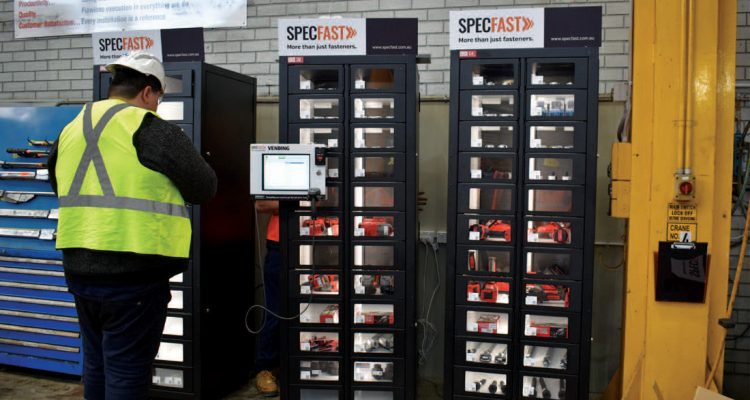Automation is rapidly seeping into almost every aspect of industrial supply chain management, having a significant impact on increased efficiency and accurate delivery of product. SpecFast, part of Motion Australia, is setting an industry standard for site-specific inventory control technology with their three-stage stock management framework.
Historically, inventory replenishment has been administered on a regular consignment basis, agreed upon by the customer and parts supplier. Due to the mostly repetitive nature of re-purchasing componentry, suppliers will be responsible for assessing stock levels, adjusting order quantities where necessary, and manually invoicing these deliveries.
This system is not without flaws, however, particularly within larger businesses or organisations with multiple workshops placing pressure on the supply chain. Replenishment lead times, assessment consistency, and communication around stock quantity requirements are all subject to fluctuation or human error, complicating operations at the end-line stage.
In answer to these long-standing issues, SpecFast has introduced a site-specific inventory monitoring system, which has been successfully implemented on an Australian site belonging to a global manufacturer operating in the earthmoving sector. Since 1965, this company has been a major supporting body to the mining industry, and is now recognised as one of Australia’s most logistically efficient plants as a result of this collaboration.
SpecFast’s inventory control products have been in place at this site since 2019, and the customer has reported evident benefits including the elimination of out-of-stocks, a simplified supply chain process, increased productivity and success meeting KPIs.
RFID Storeroom
SpecFast’s innovative Radio Frequency Identification (RFID) room serves as a secure storage facility with gated entry, detailed access records, and project monitoring capabilities. RFID tags are fitted on every stored unit, and are registered by the digital portal once removed to generate 24/7 data collection and daily activity reports.
This information is automatically fed to SpecFast’s platform, to adjust stock holding and distribution to meet future demand. Importantly, this stage of the framework allows for full traceability of batch numbers between the storeroom and the end-product machinery.
Flexsense
The customer had been using a storage rack stacked with product bins to hold fastening products that were required on a daily basis. Once the fitters had taken what they needed from this rack, the bins would be manually inspected to determine which parts needed replenishing in the next order. The need for visual inspection and manual stocktake was slowing operations down, so SpecFast implemented the Flexsense system.
This technology works by placing the bins on a load sensor, which calculates inventory as it fluctuates based on weight. It is compatible with physically small, high volume products such as fasteners, spare parts, components and consumables. The most impressive feature of Flexsense is its ability to automatically re-calculate upcoming stock orders when the minimum weight of a certain product is approached.
ProLocker
Tool changeover and traceability often slow down productivity on site, especially in larger workshops where movement between the project and storage location takes longer. ProLocker ensures that the necessary tools are readily accessible and close to hand at all times.
The ProLocker cabinets resemble vending machines for hand tools, and can be adjusted in size due to removable and interlocking shelves. Designed to be placed at convenient locations across a site, they can store a collection of nominated equipment to suit current projects. This system inherently strengthens security, and accessibility to minimise downtime.
Each locker is fitted with a battery charger, and can be accessed with an employee swipe card during scheduled time periods. Tool selection can be made via barcode, QR code, or description, and barriers requiring proof of license can be implemented if necessary. Similarly to the RFID Storeroom and Flexsense fitting, this system generates an automated data feed on the details of each interaction – what tool was taken, who by, for how long and its used. This has immediate benefits when attempting to locate certain tools, and long-term implications on increased efficiency.




